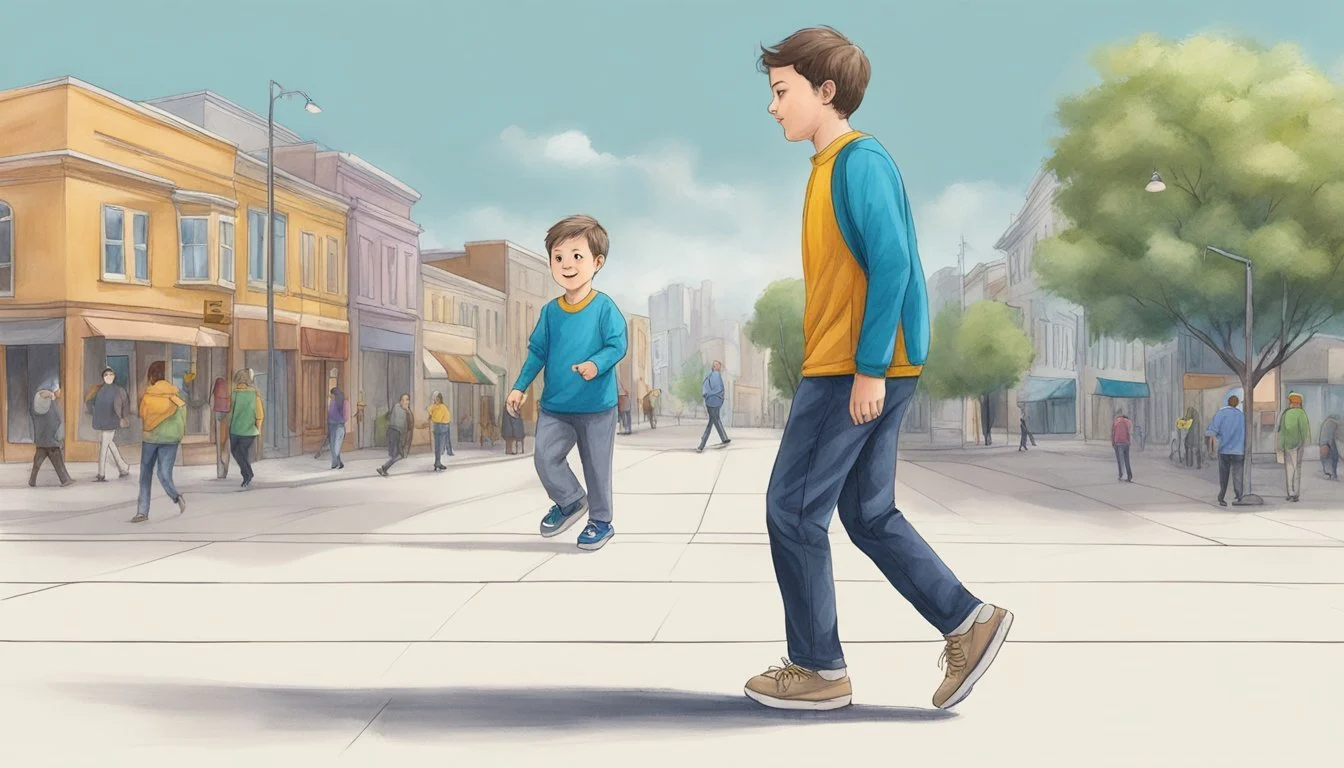Exploring Toe Walking in Autism Spectrum Disorder
Toe walking, a behavior where children walk on their tiptoes instead of using their whole foot, is commonly observed in young children. While it's often a normal part of development, persistent toe walking beyond age 3-5 can be a potential sign of autism spectrum disorder (ASD).
Children with autism may exhibit toe walking as part of their sensory processing differences or motor coordination challenges. This behavior can limit the range of motion in their feet and ankles if left unaddressed. When combined with other autism-related signs like language delays or social communication difficulties, toe walking may warrant further evaluation.
It's important to note that not all children who toe walk have autism, and not all children with autism toe walk. However, understanding this potential connection can help parents and healthcare providers identify early signs of ASD and seek appropriate interventions when necessary. Early detection and support can make a significant difference in a child's developmental outcomes and quality of life.
Understanding Autism Spectrum Disorder
Autism Spectrum Disorder (ASD) is a complex neurodevelopmental condition characterized by challenges in social interaction, communication, and repetitive behaviors. ASD affects individuals differently, with varying degrees of severity and symptom presentation.
Characteristics of ASD
Autism Spectrum Disorder encompasses a range of symptoms and behaviors. Social communication difficulties are common, including challenges in interpreting nonverbal cues and maintaining conversations. Many individuals with ASD struggle with eye contact and social reciprocity.
Repetitive behaviors and restricted interests are hallmark features. These may include hand-flapping, rocking, or intense focus on specific topics. Sensory processing differences are also prevalent, with heightened or reduced sensitivity to stimuli like sounds, lights, or textures.
Language development delays occur in some cases. Some individuals with ASD may have advanced vocabulary but struggle with pragmatic language use. Others may be nonverbal or have limited speech abilities.
Prevalence and Diagnosis
ASD affects approximately 1 in 54 children in the United States, according to recent CDC estimates. The condition is more commonly diagnosed in males than females, with a ratio of about 4:1.
Diagnosis typically occurs in early childhood, often between ages 2 and 3. However, some individuals may not receive a diagnosis until later in life. The Diagnostic and Statistical Manual of Mental Disorders (DSM-5) provides criteria for ASD diagnosis.
Evaluation involves comprehensive assessment by healthcare professionals. This may include behavioral observations, developmental screenings, and parent interviews. Early diagnosis is crucial for timely intervention and support.
ASD exists on a spectrum, with varying levels of support needs. The DSM-5 eliminated previous subcategories like Autistic Disorder and Pervasive Developmental Disorder, adopting a single diagnosis of Autism Spectrum Disorder.
Toe Walking in Children
Toe walking is a gait pattern where children walk on the balls of their feet instead of using a heel-to-toe stride. It can be a normal part of development in toddlers but may indicate underlying conditions if persistent.
Identifying Toe Walking
Toe walking is characterized by a child walking on the balls of their feet without letting their heels touch the ground. This gait pattern may be observed consistently or intermittently. Parents might notice their child struggling to walk flat-footed or having difficulty maintaining balance.
Children who toe walk may experience frequent falls or trips. They might also complain of calf pain or tightness. In some cases, toe walking can lead to reduced ankle flexibility over time.
Persistent toe walking beyond age 2-3 years warrants attention. If a child continues this gait pattern, it's advisable to consult a pediatrician or orthopedic specialist for evaluation.
Possible Causes of Toe Walking
Toe walking can have various causes, ranging from benign habits to underlying medical conditions. In many cases, it's idiopathic, meaning there's no clear cause identified.
Some children develop toe walking as a habit or sensory preference. However, it can also be a symptom of neurological or muscular disorders. Conditions associated with toe walking include:
Autism Spectrum Disorder (ASD)
Cerebral Palsy (CP)
Muscular Dystrophy
Charcot-Marie-Tooth Disease
Other neuropathies or myopathies
In children with autism, toe walking may be linked to sensory processing differences or motor planning challenges. For those with CP, it can result from increased muscle tone in the legs.
A thorough medical evaluation is crucial to determine the underlying cause and develop an appropriate treatment plan. This may involve physical examinations, gait analysis, and neurological assessments.
Medical and Developmental Implications of Toe Walking
Toe walking can have significant impacts on a child's physical development and may be associated with various medical conditions. This atypical gait pattern can affect balance, coordination, and overall motor skills.
Impact on Development
Persistent toe walking may interfere with normal motor development. It can lead to poor balance and coordination issues as children grow. Toe walkers often struggle with activities requiring stable posture or quick changes in direction.
Motor planning difficulties may arise, affecting a child's ability to sequence movements effectively. Postural instability is common, potentially impacting overall body awareness and control.
Long-term effects can include shortened calf muscles and reduced ankle flexibility. These physical changes may alter gait patterns, leading to an increased risk of falls or injuries.
Associated Conditions
Toe walking is frequently observed in children with autism spectrum disorder (ASD). Studies show a higher prevalence of toe walking in ASD populations compared to typically developing children.
Other conditions linked to toe walking include:
Cerebral palsy
Muscular dystrophy
Intellectual disability
In some cases, toe walking may indicate underlying neurological issues affecting motor control and sensory processing. It can delay the achievement of typical movement milestones.
Persistent toe walking beyond age 3 warrants professional evaluation. Early intervention is crucial to address potential developmental concerns and associated conditions.
Approaches to Addressing Toe Walking
Addressing toe walking in individuals with autism involves a combination of physical interventions, medical treatments, and behavioral techniques. These approaches aim to improve gait patterns, increase flexibility, and promote proper heel-to-ground contact.
Physical Therapy and Exercises
Physical therapy plays a crucial role in addressing toe walking. Therapists utilize active stretches to improve flexibility and range of motion in the calf muscles, including the gastrocnemius and soleus. Heel walking exercises help strengthen the muscles needed for proper foot placement.
Balance and coordination activities target the vestibular system, which may be dysfunctional in some individuals with autism. Exercises like bear walking, child's pose, and squat play can improve overall body awareness and promote a more natural gait.
Therapists may incorporate yoga-inspired movements to enhance flexibility and body control. These exercises are often tailored to the individual's needs and abilities, ensuring safety and effectiveness.
Orthopedic Interventions
When physical therapy alone is insufficient, orthopedic interventions may be necessary. Serial casting involves applying a series of casts to gradually stretch tight calf muscles and the Achilles tendon. This non-invasive approach can be effective in improving ankle flexibility.
In more severe cases, surgical correction may be recommended. This procedure aims to lengthen tight muscles or tendons, allowing for improved heel-to-ground contact. Surgery is typically considered only after other treatment options have been exhausted.
Physicians carefully assess each case to determine the most appropriate intervention. Factors such as the individual's age, severity of toe walking, and overall health are taken into account when making treatment decisions.
Behavioral Techniques
Behavioral approaches focus on reinforcing proper walking patterns. Positive reinforcement techniques reward individuals for heel-to-ground contact during walking. This method can be particularly effective for those who are responsive to social praise or tangible rewards.
TAGteach (Teaching with Acoustical Guidance) utilizes auditory stimuli to provide immediate feedback on correct foot placement. A small clicking sound signals when the heel touches the ground, helping individuals become more aware of their gait.
Parents and caregivers play a vital role in implementing these techniques consistently. Regular practice and encouragement in various settings help generalize the new walking pattern.
Support for Families and Caregivers
Families and caregivers play a crucial role in supporting children with autism who toe walk. Effective support strategies combine parental education with professional resources.
Parental Guidance and Education
Parents can learn to recognize early signs of toe walking in children with autism. This includes observing persistent walking on tiptoes and difficulty walking with heels touching the ground. Understanding these markers helps parents seek timely interventions.
Educating parents about sensory processing differences in autism is essential. Some children may toe walk due to sensory sensitivities in their feet. Parents can work with occupational therapists to develop strategies for addressing these sensitivities.
Learning simple exercises and stretches can help parents support their child's motor development at home. These might include calf stretches or activities that encourage heel-to-toe walking.
Professional and Community Resources
Autism support groups provide valuable peer connections for families. These groups often share practical advice and emotional support for managing toe walking and other autism-related challenges.
Occupational therapists and physical therapists are key professionals in addressing toe walking. They can develop personalized treatment plans and teach families effective exercises and techniques.
Pediatric orthopedists may be consulted to rule out physical causes of toe walking and recommend appropriate interventions. In some cases, they might suggest orthotics or other supportive devices.
Local autism organizations often offer workshops and seminars on various topics, including motor skill development. These can be excellent resources for families seeking to expand their knowledge and support network.


